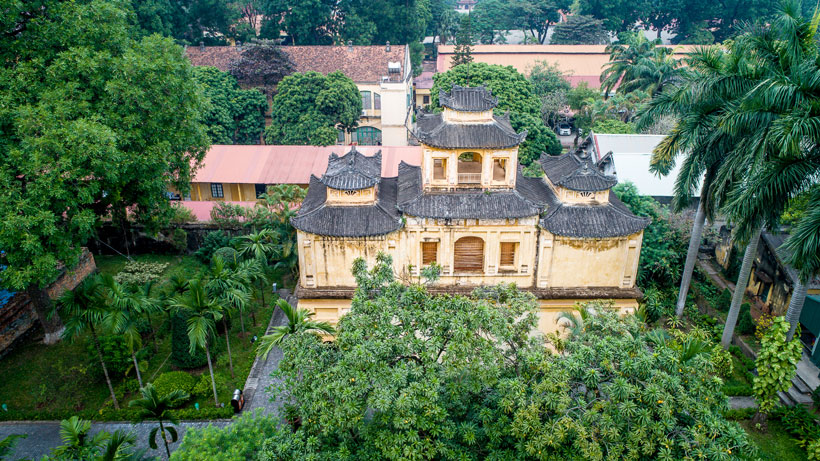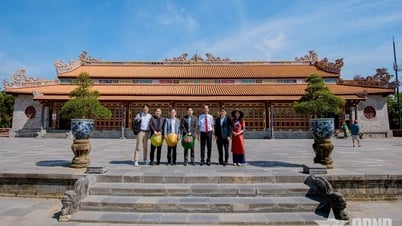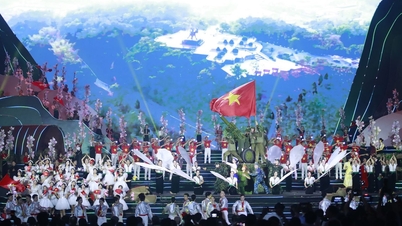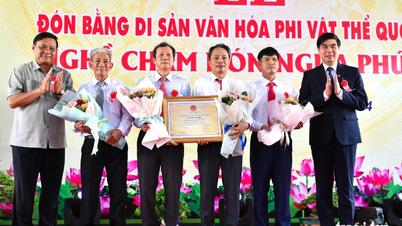Princess Hau Lau, also known as Tinh Bac Lau or Pagode des Dames (Pagode des Dames), is a unique structure, located peacefully in the heart of Thang Long Imperial Citadel, bearing deep imprints of the history of the Vietnamese dynasty. Built after the Later Le Dynasty, this place used to be the residence of the queen, princesses and concubines. During the Nguyen Dynasty, Hau Lau continued to be a resting place for the concubines who followed the king on each trip to the North, leaving behind stories about life in the harem. The building's durability over time and unique architecture have affirmed its eternal value in the flow of history.
The building was built with an area of 2,392m², solidly made of bricks, with a box-shaped lower part, and above it are delicately stacked roofs. The three-story structure of the building harmonizes traditional and modern beauty. The ground floor has three roofs, the upper floor has two roofs, modeled after the typical overlapping architecture of the Vietnamese royal court. The curved eaves at the four corners, the dragon and tiger motifs embossed on the roof add to the majesty of the building. However, by the end of the 19th century, Hau Lau was severely damaged and was renovated by the French, giving it the appearance we see today.
Hau Lau is about 2,392 square meters wide, formerly called Tinh Bac Lau, built after the Later Le Dynasty, was the residence and living place of the queen and princess. Photo: Thang Long Imperial Citadel
With a fusion of East and West architectural styles, Hau Lau has a harmonious beauty between the sophistication of Vietnamese architecture and the practicality of French architecture. The thick walls of the building help the interior space stay cool in the summer and warm in the winter, a common feature in French colonial architecture. This combination creates a beauty that is both ancient and modern, demonstrating the sophistication of the ancients in the exchange of culture and architecture. In particular, the third floor with two floors and eight roofs is ideally designed to enjoy the surrounding scenery, giving viewers a panoramic view of the entire Imperial Citadel area.
Archaeological excavations at Hau Lau in the late 1990s revealed many valuable artifacts, from sophisticated ceramic pieces from the Early Le Dynasty to traces of an ancient water wharf from the Ly - Tran Dynasty. At a depth of 3.2m, researchers found traces of a water wharf from the Le Dynasty, built with bricks and lotus-shaped stone bases typical of the Ly and Tran Dynasties. These discoveries further reinforced the role of Hau Lau in the overall central area of the Imperial Citadel of Thang Long, affirming that this was once a royal residence, a witness to many glorious dynasties in history.
The structure is built of bricks, with a box-shaped bottom and a three-story structure above. The lower floor has three roofs, the upper floor has two roofs. Photo: Thang Long Imperial Citadel
The silent walls of the Princess Palace not only contain memories of the lavish life in the harem, but are also a living testament to the existence and development of Vietnamese dynasties. Each brick and each pattern on the wall seems to tell a story of ups and downs, changes through each historical period, helping us imagine a glorious and mysterious past.
At the end of the 19th century, when Hau Lau was seriously degraded, the French began to renovate this building, giving it a new look, combining classical and modern features. However, despite many changes, Hau Lau still retains its elegant and proud beauty. The overlapping roofs, decorative motifs on the walls and the layered architecture have created a delicate and everlasting beauty.
Today, Hau Lau still stands tall in the heart of Hanoi Capital, as a silent witness to the ups and downs of the royal history. Since ancient times, this place has been a retreat for queens, princesses and beauties in the palace, now becoming an indispensable part of the Thang Long Imperial Citadel relic complex, carrying with it never-ending stories about the glory of a bygone era.




![[Photo] 12th grade students say goodbye at the closing ceremony, preparing to embark on a new journey](https://vphoto.vietnam.vn/thumb/1200x675/vietnam/resource/IMAGE/2025/5/28/42ac3d300d214e7b8db4a03feeed3f6a)
![[Photo] Vietnamese and Hungarian leaders attend the opening of the exhibition by photographer Bozoky Dezso](https://vphoto.vietnam.vn/thumb/1200x675/vietnam/resource/IMAGE/2025/5/28/b478be84f13042aebc74e077c4756e4b)
![[Photo] Prime Minister Pham Minh Chinh receives a bipartisan delegation of US House of Representatives](https://vphoto.vietnam.vn/thumb/1200x675/vietnam/resource/IMAGE/2025/5/28/468e61546b664d3f98dc75f6a3c2c880)


![[Photo] General Secretary To Lam works with the Central Policy and Strategy Committee](https://vphoto.vietnam.vn/thumb/1200x675/vietnam/resource/IMAGE/2025/5/28/7b31a656d8a148d4b7e7ca66463a6894)




















































































Comment (0)